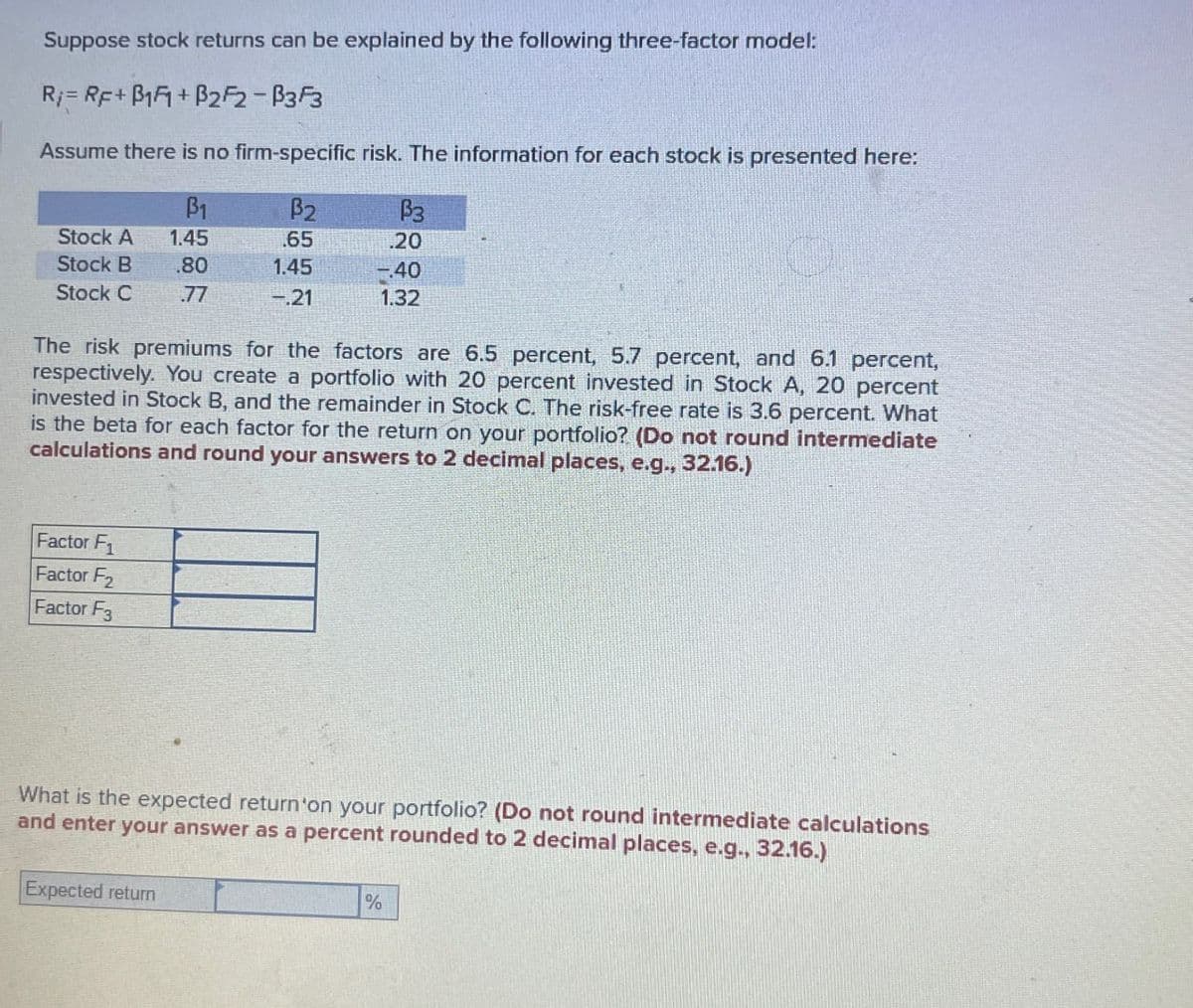Suppose stock returns can be explained by the following three-factor model: R=RF+B1F+B2F2-B3F3 Assume there is no firm-specific risk. The information for each stock is presented here: ẞ1 B2 P3 Stock A 1.45 .65 .20 Stock B .80 1.45 -.40 Stock C .77 -.21 1.32 The risk premiums for the factors are 6.5 percent, 5.7 percent, and 6.1 percent, respectively. You create a portfolio with 20 percent invested in Stock A, 20 percent invested in Stock B, and the remainder in Stock C. The risk-free rate is 3.6 percent. What is the beta for each factor for the return on your portfolio? (Do not round intermediate calculations and round your answers to 2 decimal places, e.g., 32.16.) Factor F1 Factor F2 Factor F3 What is the expected return'on your portfolio? (Do not round intermediate calculations and enter your answer as a percent rounded to 2 decimal places, e.g., 32.16.) Expected return %
Suppose stock returns can be explained by the following three-factor model: R=RF+B1F+B2F2-B3F3 Assume there is no firm-specific risk. The information for each stock is presented here: ẞ1 B2 P3 Stock A 1.45 .65 .20 Stock B .80 1.45 -.40 Stock C .77 -.21 1.32 The risk premiums for the factors are 6.5 percent, 5.7 percent, and 6.1 percent, respectively. You create a portfolio with 20 percent invested in Stock A, 20 percent invested in Stock B, and the remainder in Stock C. The risk-free rate is 3.6 percent. What is the beta for each factor for the return on your portfolio? (Do not round intermediate calculations and round your answers to 2 decimal places, e.g., 32.16.) Factor F1 Factor F2 Factor F3 What is the expected return'on your portfolio? (Do not round intermediate calculations and enter your answer as a percent rounded to 2 decimal places, e.g., 32.16.) Expected return %
Managerial Economics: Applications, Strategies and Tactics (MindTap Course List)
14th Edition
ISBN:9781305506381
Author:James R. McGuigan, R. Charles Moyer, Frederick H.deB. Harris
Publisher:James R. McGuigan, R. Charles Moyer, Frederick H.deB. Harris
Chapter1: Introduction And Goals Of The Firm
Section: Chapter Questions
Problem 1.6CE
Related questions
Question
please answer in text form and in proper format answer with must explanation , calculation for each part and steps clearly

Transcribed Image Text:Suppose stock returns can be explained by the following three-factor model:
R=RF+B1F+B2F2-B3F3
Assume there is no firm-specific risk. The information for each stock is presented here:
ẞ1
B2
P3
Stock A
1.45
.65
.20
Stock B .80
1.45
-.40
Stock C
.77
-.21
1.32
The risk premiums for the factors are 6.5 percent, 5.7 percent, and 6.1 percent,
respectively. You create a portfolio with 20 percent invested in Stock A, 20 percent
invested in Stock B, and the remainder in Stock C. The risk-free rate is 3.6 percent. What
is the beta for each factor for the return on your portfolio? (Do not round intermediate
calculations and round your answers to 2 decimal places, e.g., 32.16.)
Factor F1
Factor F2
Factor F3
What is the expected return'on your portfolio? (Do not round intermediate calculations
and enter your answer as a percent rounded to 2 decimal places, e.g., 32.16.)
Expected return
%
Expert Solution
This question has been solved!
Explore an expertly crafted, step-by-step solution for a thorough understanding of key concepts.
Step by step
Solved in 2 steps

Recommended textbooks for you

Managerial Economics: Applications, Strategies an…
Economics
ISBN:
9781305506381
Author:
James R. McGuigan, R. Charles Moyer, Frederick H.deB. Harris
Publisher:
Cengage Learning

Microeconomics: Principles & Policy
Economics
ISBN:
9781337794992
Author:
William J. Baumol, Alan S. Blinder, John L. Solow
Publisher:
Cengage Learning

Managerial Economics: Applications, Strategies an…
Economics
ISBN:
9781305506381
Author:
James R. McGuigan, R. Charles Moyer, Frederick H.deB. Harris
Publisher:
Cengage Learning

Microeconomics: Principles & Policy
Economics
ISBN:
9781337794992
Author:
William J. Baumol, Alan S. Blinder, John L. Solow
Publisher:
Cengage Learning